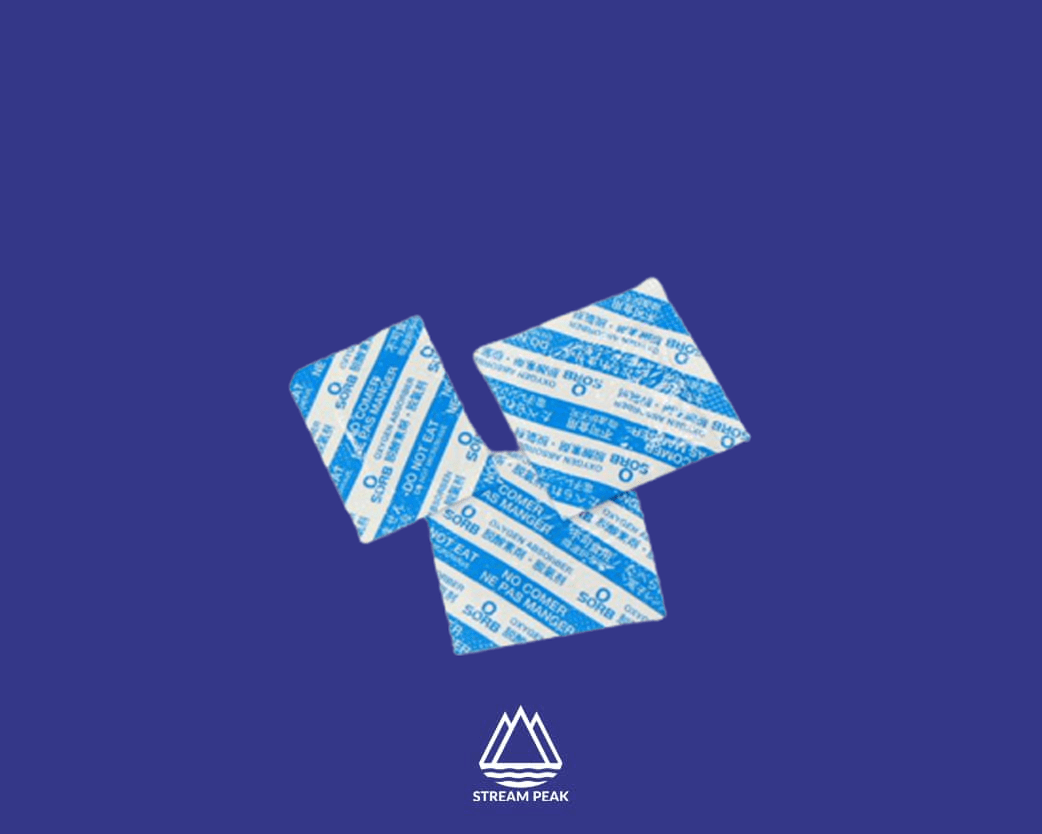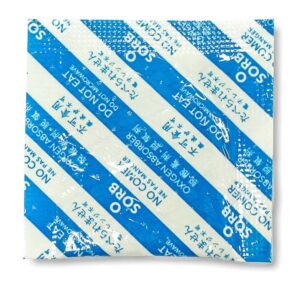What are Oxygen Absorbers?

Oxygen absorbers or oxygen scavengers preserve products’ quality by lowering the oxygen levels to .01% or below for long-term food storage. These absorbers work by removing O2 from sealed packaging to protect against insects and ensure the freshness of food for much longer periods.
By slowing down the oxidation process, the absorbers help extend a product’s shelf life by reducing the growth of aerobic pathogens such as moulds and bacteria that cause foodborne illness. The sustainable packaging solution increases consumers’ access to safe products while reducing waste due to spoilage or contamination concerns.
History of Oxygen Absorbers and Scavengers
Since the early part of the 20th century, food producers have been incorporating a range of chemicals into their products to absorb any residual oxygen that might be present. This includes substances such as ascorbic acid and glucose oxidase/catalase. In the 1960s, Japan developed and patented a system using dithionite, calcium hydroxide, activated carbon, and water for its oxygen scavenging purposes.
By the 1970s, plastic packaging with varying permeability became more widely used. Active packaging solutions were developed to prevent oxidation from residual oxygen or from oxygen transmitting through the packaging material itself; these packages contained sachets that could absorb any excess oxygen in the package.
What are Oxygen Scavengers Made Of?
Oxygen absorbers are manufactured as small porous sachets and added to food packaging, such as cans and bags, to minimise oxygen levels and ensure the food does not lose its original taste and flavour before consumption. The small packets contain an iron powder sealed in a protective material to prevent it from contacting the food.
These absorbers can be supplied in varying sizes and contain either iron powder or charcoal which chemically binds to oxygen that may be present material used for the packets allows oxygen to penetrate, allowing the iron powder to absorb oxygen molecules.
How do Oxygen Absorbers Packets Work?
Oxygen scavengers undergo a chemical reaction during which the iron powder reacts with oxygen from the air and causes it to rust. Once all the iron particles have been oxidised, the oxygen absorption stops as the absorbers become saturated.
Use the absorbers with airtight or vacuum-sealed containers to ensure the product’s safety and is unharmed by other agents such as moisture or insect infestation. The absorbers also reduce discolouration and generate unpleasant odours caused by food oxidation.
Oxygen absorbers can also be used with other food packaging solutions like silica gel for better protection. When using a desiccant packet and oxygen scavengers in the same container, it is recommended to place the desiccant at the bottom, fill the container, and then position the oxygen absorber on top before sealing it securely.
How Long Does It Take For the Absorbers to Work?
The time it takes for oxygen absorbers to work depends on various factors, including the package size, the initial oxygen content, and the absorbers’ efficiency. In most cases, oxygen absorbers start working immediately upon exposure to air. However, their complete effectiveness may take some time to achieve the desired oxygen levels.
Typically, oxygen absorbers may take anywhere from a few hours to a few days to significantly reduce the oxygen concentration within the packaging. During this time, the oxygen levels gradually decrease as the chemical reaction progresses. In some cases, achieving optimal oxygen reduction may take up to 24 to 48 hours.
It’s crucial to mention that oxygen absorbers are not a one-time-use solution. Once they come into contact with air, they absorb oxygen, and their effectiveness diminishes over time. Therefore, using them promptly after opening the packaging is advisable to maximize their potential. Several factors can impact the performance of oxygen absorbers:
- Package Size: Larger packages may require more time for the oxygen absorbers to work effectively due to the greater volume of air that needs oxygen removal.
- Oxygen Content: Higher initial oxygen levels will require more time for the absorbers to reduce the concentration to acceptable levels.
- Seal Quality: Proper sealing is essential to prevent the re-entry of external air, which could impede the absorbers’ performance.
- Absorber Type and Size: Different types and sizes of oxygen absorbers are available to suit various applications. Choosing the right absorber for your specific needs is crucial.
Oxygen absorbers over vacuum sealing
Two popular methods stand out for preserving perishable goods and sensitive products: using oxygen absorbers and vacuum sealing. Both approaches aim to extend shelf life and maintain product quality but operate on different principles.
Oxygen absorbers bring the oxygen level down to 0.01%, much lower than vacuum sealing can typically achieve. Food stored with oxygen scavengers can have a longer shelf life due to a lower oxidative rate. Oxygen absorbers allow food to be stored without being crushed or damaged. Vacuum packaging removes the air but does not remove the presence of oxygen.
The choice between oxygen absorbers and vacuum sealing depends on the product type, storage duration, and desired results. Consider the following factors when deciding which method to use:
- Product Type: Oxygen absorbers are ideal for dry goods like grains and dehydrated foods. Vacuum sealing is better suited for perishable items, liquids, and products with high moisture content.
- Storage Duration: Oxygen absorbers are a suitable option if you need long-term storage for items, especially those prone to oxidation. Vacuum sealing is better for short to medium-term storage.
- Packaging Material: Both methods work best with air-tight packaging. Ensure that your chosen packaging material complements the selected preservation method.
- Textural Sensitivity: Oxygen absorbers are the gentler option if the product is sensitive to compression, such as delicate baked goods or chips.
Both oxygen absorbers and vacuum sealing are effective methods for preserving various products, but they have distinct applications and advantages. Oxygen absorbers work best for dry goods and offer passive protection against oxidation, while vacuum sealing is versatile and well-suited for perishable items and liquids.
How to Use an Oxygen Scavenger?
Place the new oxygen absorber inside a clean, dry, airtight container with the food product and seal. It’s essential that minimal oxygen can make its way into the container as this will result in faster degradation of the food product. Examples of food products that can be used together include cakes, beans, cookies, coffee, grains, doughnuts, dry foods, dairy products, beef jerky and pasta.
During the process, it’s common to feel some heat from the oxygen absorber as it works to get rid of extra air inside the package and container. This warmth is a natural byproduct of the reaction that removes any remaining oxygen molecules. The heat may cause condensation on the outside of the exterior packet and the inside walls of the container.
Oxygen scavengers typically have a shelf life of around 2 years when stored in their sealed state. If kept in their original packaging, they can be used within this time frame. However, once the packaging is opened, it is recommended to use the oxygen absorbers within 6 months to ensure their effectiveness.
Using the Right Amount of Oxygen Absorber
Measure the volume of oxygen in your container by subtracting the product’s weight from the packaging capacity. 21% of air is made up of oxygen – Oxygen in the container (ml) = (Air volume in the container (ml) – the weight of the product (g)/specific gravity) x 0.21. Stream Peak’s Osorb is available in sizes ranging from 10 to 3000 ccs.
Look for the paper indicator before opening the packaging to ensure the absorbers are good to use. A pink indication means a good oxygen level in the package and fresh absorbers. If there is a blue indication, the bags have been exposed. After opening the packaging, use the oxygen absorbers immediately and close the storage container. As soon as the sachet is placed into the bag, seal it tight to begin its preserving process.
Containers to use with oxygen absorber packets
The most critical feature of a container used with oxygen absorber packets is its ability to provide an air-tight seal. The container should not allow external air to enter or escape once the oxygen absorber is inside. Look for containers with reliable and secure sealing mechanisms, such as screw-on lids with rubber gaskets or snap-lock lids.
Use non-porous, non-permeable materials like metal, glass, or Mylar containers to prevent oxygen from entering the container. Metal cans, Mylar bags, foil pouches, glass canning jars, and PET/PETE plastic bottles are all excellent choices for packaging with oxygen absorbers. When using these packaging materials, it is important to understand the optimal treatments for long-term food preservation, such as the best temperatures and settings.
Conclusion
Oxygen absorbers are essential in preserving the quality and freshness of various products, particularly food items. Removing oxygen from sealed containers helps prevent spoilage and extend the shelf life of products. Following the oxygen scavengers manufacturer’s instructions on using, storing, and disposing of them is crucial to maximising their effectiveness. With proper handling, oxygen absorbers can provide an effective long-term food storage solution for keeping products fresh, reducing food waste, and ultimately saving time and money.


